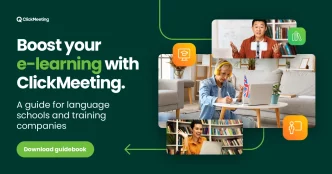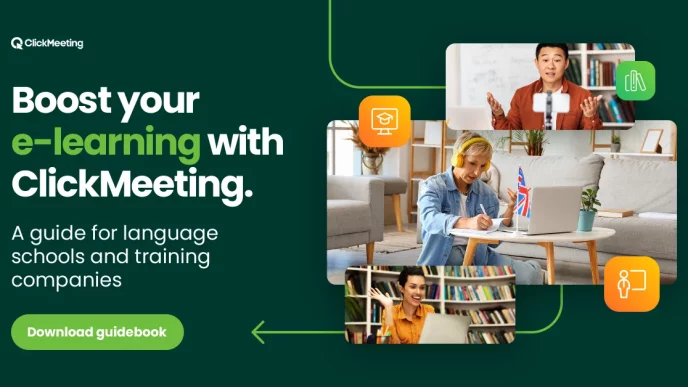Are you looking to expand your business’s online reach and engage with your audience in more meaningful ways? You should definitely host an educational webinar!
Why? It’s simple: this kind of content will allow you to share valuable knowledge, establish thought leadership, and foster a sense of community that will likely lead to more profits.
In this article, we’ll explore the benefits of educational webinars, as well as provide you with practical tips you can use to create and deliver engaging online presentations.
It doesn’t matter if you’re an independent entrepreneur or the CMO of a Fortune 500 organization. Educational webinars are a fantastic way to connect with, educate, and even sell to your target audience—if you know how to host them effectively. We’ll show you how…
Table of Contents
The Benefits of Hosting Educational Webinars
Before we teach you how to host educational webinars, let’s talk about why you should. Here are three benefits you and your business will experience once you utilize this type of content:
Audience Engagement
Educational webinars will allow you to engage your target audience in a powerful way.
By providing valuable content in a live, interactive format, you can capture the attention of attendees and keep them actively involved with your brand for a prolonged period of time.
This is something that more traditional content types—think social media posts, email newsletters, and long-form blog posts—can’t claim, which makes webinars unique.
Thought Leadership
Webinars will serve as a platform to showcase your expertise and industry knowledge, positioning you and/or your employees as thought leaders in your field.
When you share valuable insights and actionable advice with your audience, you build trust and credibility, which can ultimately lead to long-term relationships with your ideal customers.
Leads and Sales Opportunities
Educational webinars can supercharge your lead generation efforts and result in more sales.
Think about it: by crafting valuable content, you’ll attract your target audience and introduce them to your brand. Then, once you have their attention, you can pitch them your offerings.
Or, if you find that approach is too straightforward, you can simply mention your products and/or services during your presentation. At the end, you can give attendees an opportunity to learn more about them by signing up for a free demo, or your email list, etc.
Now that we know the benefits of educational webinars, let’s discuss how to host them…
Plan Your Educational Webinar
You need to carefully plan your educational webinar to ensure its success. This involves identifying your target audience, choosing relevant topics, and selecting the right format.
Identifying Your Target Audience
Before you do anything else, think about the people you want to reach with your webinar.
Are they industry professionals seeking advanced knowledge? Beginners looking for foundational information? Understanding the needs and interests of your audience will guide the direction of your webinar content and ensure it’s completely relevant to every attendee.
Choosing Relevant Topics
Once you determine who your audience is, you can select topics that will resonate with them.
Reflect on industry trends, pain points, and common queries within the field. Consider topics that align with your audience’s interests, challenges, and current affairs. By doing so, you will capture their attention and provide them with information they can use to achieve their goals.
Selecting the Right Format
The format of your educational webinar will play a pivotal role in its effectiveness. Popular formats include expert interviews, panel discussions, interactive Q&A sessions, product demos, live case studies, and solo presentations—though there are others you might consider, too..
The format you choose will depend on your audience and unique goals. Select one that will help you maximize the learning experience for attendees, while allowing you to accomplish your business objectives at the same time. This is the sweet spot you should aim for.
(Note: you can mix formats, as well. For example, you can host an expert interview, then close with a product demo. Just make sure the two formats you combine make sense together.)
Promote Your Educational Webinar
Now that you’ve planned your educational webinar content, you need to promote it.
Fortunately, email marketing, social media sites, and industry influencers make this much easier to do than it otherwise would be. Here’s how to use these various channels effectively:
Email Marketing
Does your business have an email list? Then you should definitely use it to market your educational webinar. Doing so will help you secure attendees who are interested in the information you plan to share. Just make sure you craft compelling and personalized email invitations that clearly articulate the value your audience will receive during your event.
Also worth noting, one email is never enough. Remind your subscribers about your upcoming webinar on a regular basis—even the ones who’ve already registered for it.
Social Media Sites
Social media is an invaluable promotional tool.
Take advantage of the Facebooks, Instagrams, and TikToks of the world to connect with potential attendees and tell them about your education webinar.
You can do this by sharing images and short video clips regarding your event, then encouraging your followers to re-share them. Hashtags will help you increase discoverability and market your event to potential attendees as well. We suggest using them in your promo efforts.
Industry Influencers
Every industry has influencers. You can grow attendance for your educational webinar by partnering with one of them to help promote your event. The key to success with this tactic is common sense. Only partner with influencers who serve a similar audience.
While influencers can aid your marketing efforts, they can also lend your event credibility. Potential attendees will think, “Well, if so-and-so says it’s a good event, it probably is. I’ll register and check it out.” This is another reason why working with influencers can be so valuable.
The Technical Side of Hosting Webinars
Congratulations! You’ve planned and promoted your educational webinar. Now what? Now you need to make sure you have your tech stack in order. Here’s what we recommend:
Select the Right Webinar Platform
You can’t host a quality webinar without top-level webinar software. When choosing a platform for your business, consider factors such as the number of attendees you expect to receive, interactivity features like polls and chat, and integration capabilities with the other tools you use.
Or, just go with ClickMeeting. Our industry-leading platform is used by tens of thousands of people in 125+ countries around the world. Why? Because it’s easy to use and powerful.
Sign up for a free 14-day trial of our software today to access custom branding, screen sharing, digital whiteboards, polls and surveys, moderated chat, webinar recording, analytics, and more.
Test Equipment and Connectivity
Have you picked a webinar platform? Great, now you can test your equipment.
Make sure your software runs, your external cameras and microphones connect properly, and individual app features, like screen sharing and custom polls, do what you need them to do.
Technical difficulties will harm your brand’s reputation. As such, they should be avoided at all costs, which is why a pre-webinar test run is always a good idea. Don’t skip this step!
Maximizing Engagement and Interaction
The best webinars are interactive. You don’t want your attendees to observe, you want them to engage and participate. These three tips will help make sure those things happen:
Encourage Audience Participation
First, encourage audience participation by creating an interactive environment.
Engaging visuals, compelling storytelling, and relatable examples that capture your audience’s attention will naturally prompt attendees to share their thoughts, opinions, and experiences. Try to add as many of these elements to your educational webinars—you’ll be glad you did!
Use Polls, Surveys, and Q&A Sessions
One of the best ways to engage your audience is to ask them questions, which you can do via polls, surveys, and/or Q&A sessions.
Polls provide a dynamic way to gather real-time feedback and insights from your viewers, making them feel involved and valued. Q&A sessions allow participants to seek clarification on the information you share and actively participate in your event. Surveys are often used after webinars conclude to measure performance. (More on this in the next section.)
All three of these tools can be utilized to increase engagement and, therefore, success.
Providing Post-Webinar Resources and Follow-Ups
The best educational webinars encourage audience engagement during and after the event.
Connect with attendees post-webinar by providing them with additional reading materials, valuable downloadables, follow-up email sequences, exclusive offers that relate to your webinar topic, and more. These things will help you continue interacting with your audience in the future.
Measuring the Success of Your Webinar
Was your webinar effective? You won’t know until you measure the results. Fortunately, doing so is quite simple. Here are three tips to help you with this crucial process:
Analyze Registration and Attendance Rates
How many people registered for your educational webinar? How many of them attended?
Both registration and attendance rates will help you determine the popularity of your webinar topics and the quality of your marketing efforts. The difference between the two will allow you to evaluate your approach to email marketing.
For example, if rates are low, you should consider sending more reminder emails in the future. If rates are high, continue deploying your current strategy.
Review Audience Feedback and Engagement Metrics
As mentioned above, post-webinar surveys will help you learn what attendees liked and disliked about your educational webinar. Make sure you take this feedback seriously!
We suggest studying engagement metrics, too. How many people answered your in-webinar polls? How many questions did you receive during your Q&A session? What percentage of your audience watched your event from start to finish? The answers to these questions will help you determine the quality of your content, which you can then adjust for future webinars.
Track Post-Webinar Conversions
Last but not least, track post-webinar conversions. Doing so will help you measure your webinar’s influence on audience behavior, and therefore, assess the event’s level of success.
Just remember, a conversion can be many different things. Product sales count, of course. But so do email sign ups and content downloads, assuming the goal of your educational webinar was to achieve these things. Basically, almost any desired action should count as a conversion.
Elevate Your Business With Educational Webinars
As we’ve seen in this article, educational webinars will help you expand your audience, establish your expertise in your field, and drive engagement with your target audience.
All you have to do to make this content type work for you is plan stellar content, promote your event effectively, test your technology, engage your audience, and measure your results.
Of course, these things are easier to do when working with a quality webinar platform.
Sign up for your free 14-day trial of ClickMeeting today to see if our solution meets your needs. If it does, you can sign up for a paid plan for as low as $26 a month. See you on the inside!











